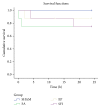Protective effect of shen-fu injection on neuronal mitochondrial function in a porcine model of prolonged cardiac arrest
- PMID: 25505924
- PMCID: PMC4258377
- DOI: 10.1155/2014/523847
Protective effect of shen-fu injection on neuronal mitochondrial function in a porcine model of prolonged cardiac arrest
Abstract
Background. Shen-Fu injection (SFI) following cardiac arrest exhibits neurological effects, but its effect on neurological dysfunction is unclear. This study sought to investigate the protective effect of SFI on nerve cells in a porcine model of cardiac arrest. Methods. After eight minutes of untreated ventricular fibrillation (VF) and 2 minutes of basic life support, 24 pigs were randomized and divided into three cardiopulmonary resuscitation groups, which received central venous injection of either Shen-Fu (SFI group; 1.0 ml/kg), epinephrine (EP group; 0.02 mg/kg), or saline (SA group). Surviving pigs were sacrificed at 24 h after ROSC and brains were removed for analysis for morphologic changes of mitochondria by electron microscopy, for mitochondrial transmembrane potential (MTP) by flow cytometry, and for opening of the mitochondrial permeability transition pore (MPTP) by mitochondrial light scattering. Results. Compared with the EP and SA groups, SFI treatment reduced opening of MPTP, showing higher MMP. In addition, animals treated with SFI showed slight cerebral ultrastructure damage under the electron microscopy. Conclusion. Shen-Fu injection alleviated brain injury, improved neurological ultrastructure, stabilized membrane potential, and inhibited opening of MPTP. Therefore, SFI could significantly attenuate postresuscitation cerebral ischemia and reperfusion injury by modulating mitochondrial dysfunction of nerve cells.
Figures





Similar articles
-
Shen-fu injection reduces postresuscitation myocardial dysfunction in a porcine model of cardiac arrest by modulating apoptosis.Shock. 2012 Aug;38(3):301-6. doi: 10.1097/SHK.0b013e31825f6632. Shock. 2012. PMID: 22683733
-
Comparison of epinephrine and Shen-Fu injection on resuscitation outcomes in a porcine model of prolonged cardiac arrest.Chin Med J (Engl). 2014;127(4):724-8. Chin Med J (Engl). 2014. PMID: 24534230
-
Effects of Shen-Fu Injection () on apoptosis of regulatory T lymphocytes in spleen during post-resuscitation immune dysfunction in a porcine model of cardiac arrest.Chin J Integr Med. 2016 Sep;22(9):666-73. doi: 10.1007/s11655-016-2505-2. Epub 2016 Sep 11. Chin J Integr Med. 2016. PMID: 27614451
-
Effect of Shenfu on inflammatory cytokine release and brain edema after prolonged cardiac arrest in the swine.Am J Emerg Med. 2013 Aug;31(8):1159-64. doi: 10.1016/j.ajem.2013.03.020. Epub 2013 Jun 24. Am J Emerg Med. 2013. PMID: 23806725
-
The roles of traditional chinese medicine: shen-fu injection on the postresuscitation care bundle.Evid Based Complement Alternat Med. 2013;2013:319092. doi: 10.1155/2013/319092. Epub 2013 Aug 28. Evid Based Complement Alternat Med. 2013. PMID: 24066009 Free PMC article. Review.
Cited by
-
Clinical Effect of Shenfu Injection in Patients with Septic Shock: A Meta-Analysis and Systematic Review.Evid Based Complement Alternat Med. 2015;2015:863149. doi: 10.1155/2015/863149. Epub 2015 Jun 14. Evid Based Complement Alternat Med. 2015. PMID: 26199638 Free PMC article.
-
Investigation of the pharmacological mechanisms of Shenfu injection in acute pancreatitis through network pharmacology and experimental validation.Heliyon. 2024 Sep 5;10(18):e37491. doi: 10.1016/j.heliyon.2024.e37491. eCollection 2024 Sep 30. Heliyon. 2024. PMID: 39309824 Free PMC article.
-
Protective effect of Shenfu injection preconditioning on lung ischemia-reperfusion injury.Exp Ther Med. 2016 Sep;12(3):1663-1670. doi: 10.3892/etm.2016.3549. Epub 2016 Jul 26. Exp Ther Med. 2016. PMID: 27602083 Free PMC article.
-
Novel Role of Carbon Monoxide in Improving Neurological Outcome After Cardiac Arrest in Aged Rats: Involvement of Inducing Mitochondrial Autophagy.J Am Heart Assoc. 2019 May 7;8(9):e011851. doi: 10.1161/JAHA.118.011851. J Am Heart Assoc. 2019. PMID: 31030597 Free PMC article.
-
Effects of Shenfu Injection in the Treatment of Septic Shock Patients: A Multicenter, Controlled, Randomized, Open-Label Trial.Evid Based Complement Alternat Med. 2016;2016:2565169. doi: 10.1155/2016/2565169. Epub 2016 Jun 30. Evid Based Complement Alternat Med. 2016. PMID: 27446222 Free PMC article.
References
-
- Gong P., Li C.-S., Hua R., Zhao H., Tang Z.-R., Mei X., Zhang M.-Y., Cui J. Mild hypothermia attenuates mitochondrial oxidative stress by protecting respiratory enzymes and upregulating mnsod in a pig model of cardiac arrest. PLoS ONE. 2012;7(4) doi: 10.1371/journal.pone.0035313.e35313 - DOI - PMC - PubMed
-
- Reisinger J., Höllinger K., Lang W., Steiner C., Winter T., Winter A., Mori M., Lindorfer A., Kiblböck D., Siostrzonek P. Does early administration of selenium improve neurological outcome after cardiac arrest? The American Journal of Emergency Medicine. 2009;27(2):176–181. doi: 10.1016/j.ajem.2008.01.020. - DOI - PubMed
LinkOut - more resources
Full Text Sources
Other Literature Sources

